

Learning Targets. Definition Learning Targets are the highly concrete and specific skill- and content-building blocks that students undertake to each the articulated Objectives or Goals at each level of a Learning Progression.
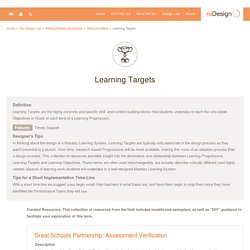
Designer's Tips In thinking about the design of a Mastery Learning System, Learning Targets are typically articulated late in the design process as they aren't essential to a launch. Over time, research-based Progressions will be more available, making this more of an adoption process than a design process. This collection of resources provides insight into the distinctions and relationship between Learning Progressions, Learning Targets and Learning Objectives.
Tips for a Short Implementation Time-Line With a short time-line we suggest yoou begin small: train teachers in what these are, and have them begin to map them once they have identified the Performance Tasks they will use. Science Assessment ~ Log In/Registration. Summary%20of%20Walvoord%20and%20Anderson%20Effective%20Grading.pdf. 40600533.pdf. Short%20Assignment%20Mihans%20for%20PDF.pdf. Counting Worksheets. Illinois State Board of Education - Illinois Learning Standards. The University of Arizona - Institute for Mathematics & Education. The Common Core State Standards in mathematics were built on progressions: narrative documents describing the progression of a topic across a number of grade levels, informed both by research on children's cognitive development and by the logical structure of mathematics. These documents were spliced together and then sliced into grade level standards. From that point on the work focused on refining and revising the grade level standards.
The early drafts of the progressions documents no longer correspond to the current state of the standards. It is important to produce up-to-date versions of the progressions documents. Illinois State Board of Education - ELA/Literacy Learning Progressions. Common Core Mathematics Curriculum Models. College and Career Readiness The Illinois State Board of Education has been charged by the Illinois 97th General Assembly to implement Public Act 97-704. The State Board of Education is to coordinate the acquisition, adaptation, and development of middle and high school Mathematics Curriculum Models to aid school districts and teachers in implementing Common Core Mathematics State Standards for all students.
Public Act 97-704 required representation from statewide educational organizations and stakeholders. A committee consisting of a middle school mathematics team and a high school mathematics team was created to address this charge. The charge was to develop model middle and high school course designs that demonstrated effective student pathways to mathematics-standards attainment by graduation. Illinois Learning Standards for Social/Emotional Learning(SEL) The standards describe the content and skills for students in grades K - 12 for social and emotional learning. Grade_4_20130130_135028_59. Combined Topic Arrangement 5.1.13.pdf. Working with the NGSS Performance Expectations. Working with NGSS There are a number of considerations to keep in mind when working with NGSS.
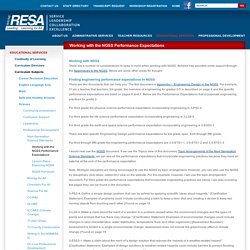
Achieve has provided some support through the Appendices to the NGSS. Below are some other areas for thought: Finding engineering performance expectations in NGSS There are two documents that can help you. InsideTheNGSSBox.pdf. NGSS%20Performance%20Expectation%20Analysis%20Guide.pdf. Students with Disabilities (KSDE Assessment Literacy Project) YouTube. Standardized Assessments & Formative vs. Summative Evaluations. Teachers Surveyed on Using Digital Games in Class: What is the Biggest Barrier? Teachers Surveyed on Using Digital Games in Class: What is the Biggest Barrier?

A recent survey by the Gamesandlearning.org a project run by the Joan Ganz Cooney Center at Sesame Workshop had some very dismal statistics when it came to the barriers teachers feel when implementing digital games in their classrooms. Teachers with Apps has been trying to raise awareness for the need for schools to embrace technology and get students ready for the future. In September of this year TWA posted a blog titled, 8 Reasons why the implementation of tech in schools is so slow, which echoes much of what this survey reveals. Although we didn’t site time specifically on our list, it topped their survey with 45% of teachers considering it the biggest barrier to getting tech into the classroom.
A Juicy Collection of Bloom's Digital Taxonomies! Today, educators are overwhelmed (literally drowning!)
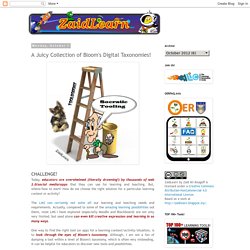
By thousands of web 2.0/social media/apps that they can use for learning and teaching. But, where/how to start? How do we choose the right solution for a particular learning context or activity? The LMS can certainly not solve all our learning and teaching needs and requirements. Actually, compared to some of the amazing learning possibilities out there, most LMS I have explored (especially Moodle and Blackboard) are not only very limited, but used alone can even kill creative expression and learning in so many ways.
One way to find the right tool (or app) for a learning context/activity/situation, is to look through the eyes of Bloom's taxonomy. But, please keep in mind that many tools/apps can easily be used for all the levels of Bloom's taxonomy with an open and creative mindset. Here is a collection of Bloom's digital taxonomies that I have discovered until now: Updated version (2014): Old Version: Source Source Source. Principles.pdf. Why Is Assessment Important? Assessment is an integral part of instruction, as it determines whether or not the goals of education are being met.
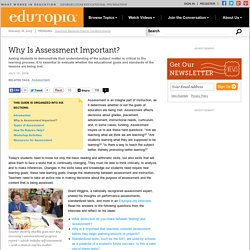
Assessment affects decisions about grades, placement, advancement, instructional needs, curriculum, and, in some cases, funding. Measurement and Assessment in Teaching, 10/e. Scientific Method Educational Videos. Blooms Taxonomy According to Seinfeld. Assessment Professional Development Guide. An overview of the Edutopia professional development guide for understanding the many ways to assess student learning in the classroom.
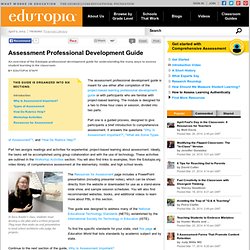
The assessment professional development guide is meant for use either after completion of the project-based learning professional development guide or with participants who are familiar with project-based learning. The module is designed for a two to three hour class or session, divided into two parts. Part one is a guided process, designed to give participants a brief introduction to comprehensive assessment.
It answers the questions "Why Is Assessment Important? "